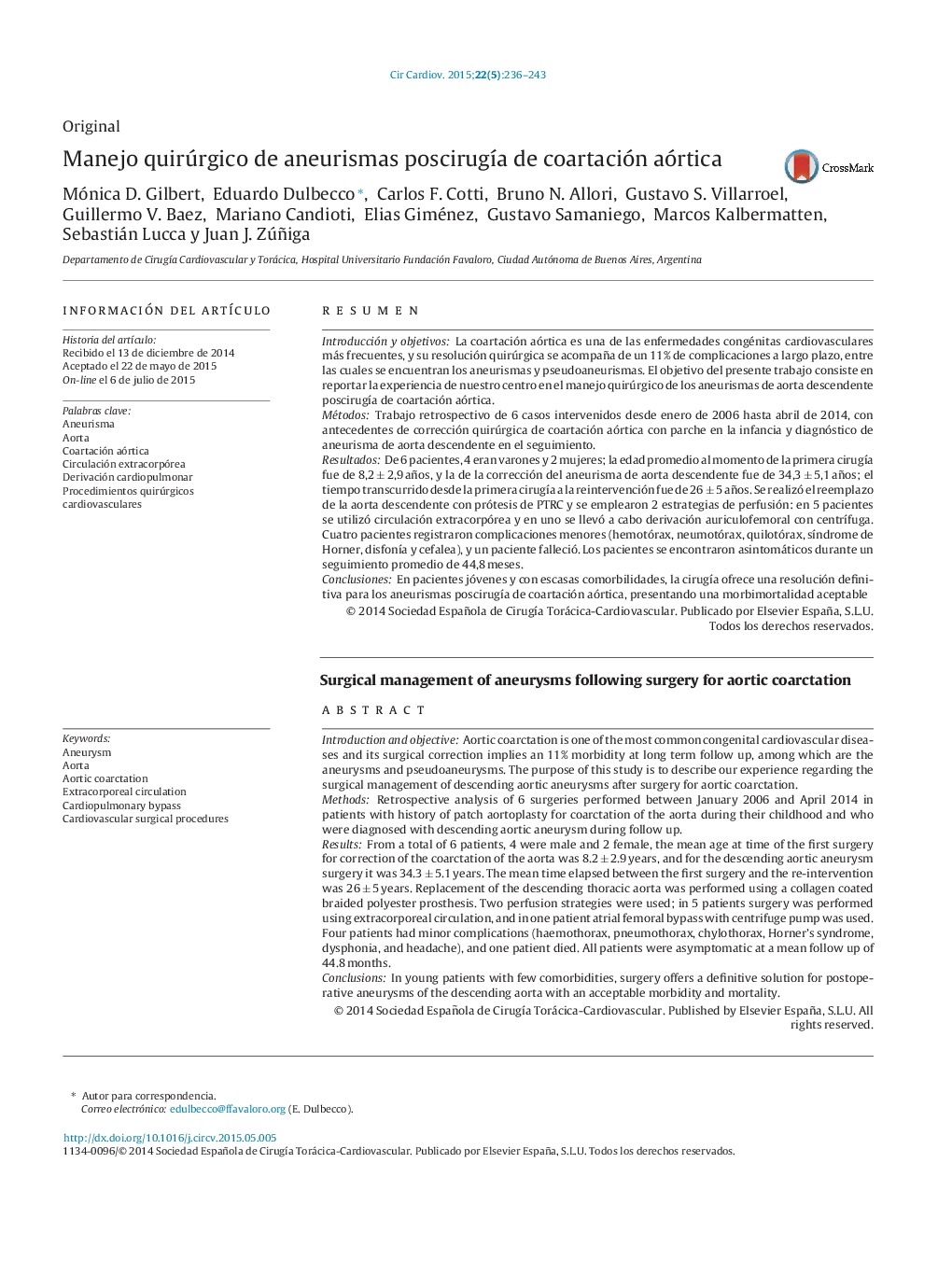| Article ID | Journal | Published Year | Pages | File Type |
|---|---|---|---|---|
| 2907417 | Cirugía Cardiovascular | 2015 | 8 Pages |
ResumenIntroducción y objetivosLa coartación aórtica es una de las enfermedades congénitas cardiovasculares más frecuentes, y su resolución quirúrgica se acompaña de un 11% de complicaciones a largo plazo, entre las cuales se encuentran los aneurismas y pseudoaneurismas. El objetivo del presente trabajo consiste en reportar la experiencia de nuestro centro en el manejo quirúrgico de los aneurismas de aorta descendente poscirugía de coartación aórtica.MétodosTrabajo retrospectivo de 6 casos intervenidos desde enero de 2006 hasta abril de 2014, con antecedentes de corrección quirúrgica de coartación aórtica con parche en la infancia y diagnóstico de aneurisma de aorta descendente en el seguimiento.ResultadosDe 6 pacientes, 4 eran varones y 2 mujeres; la edad promedio al momento de la primera cirugía fue de 8,2 ± 2,9 años, y la de la corrección del aneurisma de aorta descendente fue de 34,3 ± 5,1 años; el tiempo transcurrido desde la primera cirugía a la reintervención fue de 26 ± 5 años. Se realizó el reemplazo de la aorta descendente con prótesis de PTRC y se emplearon 2 estrategias de perfusión: en 5 pacientes se utilizó circulación extracorpórea y en uno se llevó a cabo derivación auriculofemoral con centrífuga. Cuatro pacientes registraron complicaciones menores (hemotórax, neumotórax, quilotórax, síndrome de Horner, disfonía y cefalea), y un paciente falleció. Los pacientes se encontraron asintomáticos durante un seguimiento promedio de 44,8 meses.ConclusionesEn pacientes jóvenes y con escasas comorbilidades, la cirugía ofrece una resolución definitiva para los aneurismas poscirugía de coartación aórtica, presentando una morbimortalidad aceptable
Introduction and objectiveAortic coarctation is one of the most common congenital cardiovascular diseases and its surgical correction implies an 11% morbidity at long term follow up, among which are the aneurysms and pseudoaneurysms. The purpose of this study is to describe our experience regarding the surgical management of descending aortic aneurysms after surgery for aortic coarctation.MethodsRetrospective analysis of 6 surgeries performed between January 2006 and April 2014 in patients with history of patch aortoplasty for coarctation of the aorta during their childhood and who were diagnosed with descending aortic aneurysm during follow up.ResultsFrom a total of 6 patients, 4 were male and 2 female, the mean age at time of the first surgery for correction of the coarctation of the aorta was 8.2 ± 2.9 years, and for the descending aortic aneurysm surgery it was 34.3 ± 5.1 years. The mean time elapsed between the first surgery and the re-intervention was 26 ± 5 years. Replacement of the descending thoracic aorta was performed using a collagen coated braided polyester prosthesis. Two perfusion strategies were used; in 5 patients surgery was performed using extracorporeal circulation, and in one patient atrial femoral bypass with centrifuge pump was used. Four patients had minor complications (haemothorax, pneumothorax, chylothorax, Horner's syndrome, dysphonia, and headache), and one patient died. All patients were asymptomatic at a mean follow up of 44.8 months.ConclusionsIn young patients with few comorbidities, surgery offers a definitive solution for postoperative aneurysms of the descending aorta with an acceptable morbidity and mortality.
